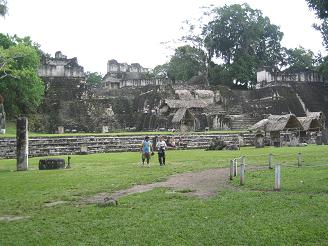Tikal
The Honduras-Guatemala border crossing goes well. Within an hour I am riding a zigzag course for the Mayan ruinas of Tikal. As I ride the Penìnsula de Yucatàn north I reflect on the history read in preparation for this amazing city of 100,000 and 60 square kilometres. The Tikal site was first inhabited around 600 BC but by AD 869, the last ruler, Hasaw Chan K'awill II, was watching the near end of his city state. By the time the conquistadors arrived in the 1500's, the Yucatán jungle had a several-century head start of invasion.
In more modern history, an interesting invasion of another sort took place. Around the turn of the 20th century, companies like the United Fruit Company and the Standard Fruit Company were developing banana plantations and in the process, getting government consessions to build railroads, ports, electricity plants, suppy shops and of course aquire much land. When exports ballooned and American interests grew to the point where 40% of all exports were US controlled, the "banana republics" revolted. That is, the latin american workers revolted. Government crackdowns occurred, happily bankrolled by US bucks and other "help-in-kind". Whether Mayan, Aztec, Sendero Luminoso, Sandinista or Zapatista, there seems no historical shortage of worthy causes to sign up for.
Hey, but then there is another kind of invader. How about two lovely women from Sweden? That can't be bad, can it? I meet Ewa Persson and Lisa Lundgren at the Hotel Tikal Inn. We have a most interesting visit in the evening by the pool. Big stars overhead. Of course we have to celebrate Lisa's birthday with a bottle of wine.
At 4:30 a.m. I am up and walking in the dark to meet the Tikal guide. By 5:20 a group of us are sitting on the top of Temple IV 120 feet up, waiting for sunrise. It comes, but it is more like fogrise. Nevermind, the sounds of the jungle waking up at that hour make up for lack of actual sun. Howler and spider monkeys, macaws, woodpeckers and tucans all compete for air time.
Tikal has over 3000 structures. Only 15% have been even partially restored. Our guide takes us on a quick four hour tour around the main structures; nevertheless it seems "downtown" was still a healthy 2.5 square km.
Tikal's main structures were constructed from AD 550 to AD 900 during the Late Classic Period. For those wanting to refresh their memories, the Old Age was from 1500 BC to AD 200, the whole Classic period was from AD 200 to AD 925. The last date recorded on a Tikal stela is AD 889.
Most archaeologists now agree the collapse of this great empire was due to warfare with neighbouring states, over population - which resulted in environmental destruction, and drought. Is anyone besides me seeing a parallel with what seems to be happening today? Who was it that said something like, "those who refuse to learn from history are damned to repeat it"?
After Tikal, Katie and I are on the road south to the island town of Flores, on Lago Petèn Itzà. The ride with jungle trees arching over the road is cool.
I like little towns like this. So much so that after the daily thunderstorm I go for a walk and take photos of whatever takes my fancy. I am easily amused but there is a lot to be amused by.
Not even another evening rainstorm can discourage me from breaking out a Nicaraguan cigar, pouring a Ron Botran rum and sitting on the second story terrace of my hotel. Out of the rain of course. From my sheltered little spot I look out over the lake of Petén Itzà. Sky and lake share the same flat, uniform grey. Baby raindrops pockmark the lake's smooth skin. I can't feel the air temperature but the humidity must be 199%. To my right, a rooster crows from under a coconut palm. What in hell is a rooster doing cock-a-doodle-doing at this hour? His shelter, the palm fronds, droop heavy from the weight of all this rain. He needs a rum more than I do.
On the tan-colored gravel below my balcony, Flores' "Marine Drive", tuk-tuks splash through rain puddles. Families of three on 125 cc scooters, with child in front, dad driving, mom on back, putter by. None are wearing helmets.
Out along the shoreline, spanish voices drift from the wharf nearby, their muffled words echoing across the water. The cigar tastes smooth. So does the rum. Just a smooth day all round.








